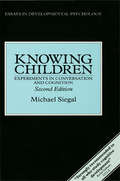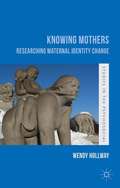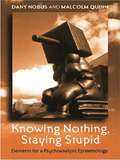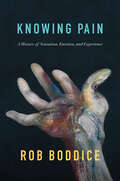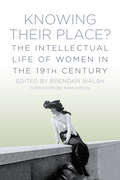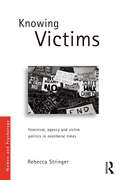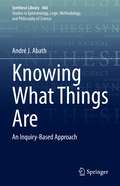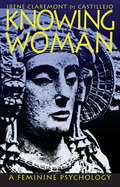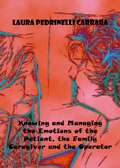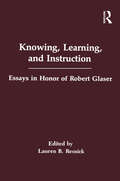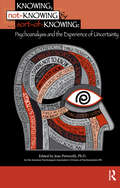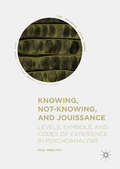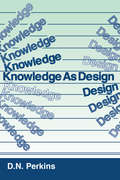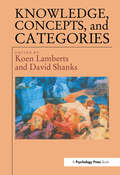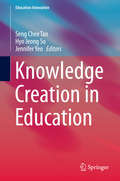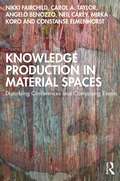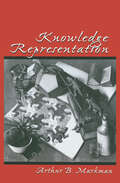- Table View
- List View
Knowing Children: Experiments in Conversation and Cognition (Essays in Developmental Psychology)
by Michael SiegalIt has often been maintained that young children's knowledge is limited to perceptual appearances. In this "preoperational" stage of development, there are profound conceptual limitations in that they have little understanding of numerical and causal relations and are incapable of insight into the minds of others. Their apparent inability to perform well on traditional developmental measures has led researchers to accept a model of the young child as plagued by conceptual deficits. These ideas have had a major impact on educational programs. Many have accepted the view that the young are not ready for instruction and that their memory and understanding is vulnerable to distortion, especially in subjects such as mathematics and science. However, the second edition of this book provides further evidence that children's stage-like performance can frequently be reinterpreted in terms of a clash between the conversational worlds of adults and children. In many settings, children may not share an adult's well-meaning purpose or use of words in questioning. Under these conditions, they do not disclose the depth of their memory and understanding and may respond incorrectly even when they are certain of the right answer.In this light, a different model of development emerges with significant implications for instruction in educational, health, and legal settings. It attributes more competence to young children than is frequently recognized and reflects the position that development in evolutionarily important domains is guided by implicit constraints on learning. It proposes that attention to young children's conversational experience is a powerful means to illustrate what they know.
Knowing Feeling: Affect, Script, and Psychotherapy
by Donald L. NathansonNathanson and his colleagues explore contemporary affect studies, focusing on the work of Silvan Tomkins, and examine their impact on the theory and practice of psychotherapy.
Knowing Mothers
by Wendy HollwayHow do women experience the identity changes involved in becoming mothers for the first time? Throughout in depth case examples, Wendy Hollway demonstrates how a different research methodology, underpinned by a psychoanalytically informed epistemology, can transform our understanding of the early foundations of maternal identity.
Knowing Nothing, Staying Stupid: Elements for a Psychoanalytic Epistemology
by Dany Nobus Malcolm QuinnWhy is stupidity sublime? What is the value of a 'dialectics of ignorance' for analysts and academics? Knowing Nothing, Staying Stupid draws on recent research to provide a thorough and illuminating evaluation of the status of knowledge and truth in psychoanalysis. Adopting a Lacanian framework, Dany Nobus and Malcolm Quinn question the basic assumption that knowledge is universally good and describe how psychoanalysis is in a position to place forms of knowledge in a dialectical relationship with non-knowledge, blindness, ignorance and stupidity. The book draws out the implications of a psychoanalytic theory of knowledge for the practices of knowledge construction, acquisition and transmission across the humanities and social sciences. The book is divided into two sections. The first section addresses the foundations of a psychoanalytic approach to knowledge as it emerges from clinical practice, whilst the second section considers the problems and issues of applied psychoanalysis, and the ambiguous position of the analyst in the public sphere. Subjects covered include: The Logic of Psychoanalytic Discovery Creative Knowledge Production and Institutionalised Doctrine The Desire to Know versus the Fall of Knowledge Epistemological Regression and the Problem of Applied Psychoanalysis This provocative discussion of the dialectics of knowing and not knowing will be welcomed by practicing psychoanalysts and students of psychoanalytic studies, but also by everyone working in the fields of social science, philosophy and cultural studies.
Knowing Pain: A History of Sensation, Emotion, and Experience
by Rob BoddicePain, while known to almost everyone, is not universal. The evidence of our own pain, and our own experience, does not provide us with automatic insight into the pains of others, past or present. No matter how self-evident and ubiquitous the sting of a paper cut or the desolation of heartbreak might seem, pain is situated and historically specific. In a work that is sometimes personal, always political, Rob Boddice reveals a history of pain that juggles many disciplinary approaches and disparate languages to tackle the thorniest challenges in pain research. He explores the shifting meaning-making processes that produce painful experiences, expanding the world of pain to take seriously the relationship between pain’s physicality and social and emotional suffering. Ranging from antiquity to the present and taking in pain knowledge and pain experiences from around the world, his tale encompasses not only injury, but also grief, exclusion, chronic pain, and trauma, and reveals how knowledge claims about pain occupy what pain is like. Innovative and compassionate in equal measure, Knowing Pain puts forward an original pain agenda that is essential reading for those interested in the history of emotions, senses, and experience, for medical researchers and practitioners, and for anyone who has known pain.
Knowing Their Place?: The Intellectual Life of Women in the 19th Century
by Brendan Walsh Pam HirschKnowing their Place is a comprehensive account of the public, private and intellectual life of Irish women in the Victorian age. In particular, this book looks at the steady progress of girls and women within the education system, their gradual involvement in intellectual life through amateur societies (such as the Royal Dublin Society); their emergence of independent, highly motivated scholarly and philanthropic individuals who operated within local spheres with often very considerable degrees of success and influence.
Knowing Victims: Feminism, agency and victim politics in neoliberal times (Women and Psychology)
by Rebecca StringerKnowing Victims explores the theme of victimhood in contemporary feminism and politics. It focuses on popular and scholarly constructions of feminism as ‘victim feminism’ – an ideology of passive victimhood that denies women’s agency – and provides the first comprehensive analysis of the debate about this ideology which has unfolded among feminists since the 1980s. The book critically examines a movement away from the language of victimhood across a wide array of discourses, and the neoliberal replacement of the concept of structural oppression with the concept of personal responsibility. In derogating the notion of ‘victim,’ neoliberalism promotes a conception of victimization as subjective rather than social, a state of mind, rather than a worldly situation. Drawing upon Nietzsche, Lyotard, rape crisis feminism and feminist philosophy, Stringer situates feminist politicizations of rape, interpersonal violence, economic inequality and welfare reform as key sites of resistance to the victim-blaming logic of neoliberalism. She suggests that although recent feminist critiques of ‘victim feminism’ have critically diagnosed the anti-victim movement, they have not positively defended victim politics. Stringer argues that a conception of the victim as an agentic bearer of knowledge, and an understanding of resentment as a generative force for social change, provides a potent counter to the negative construction of victimhood characteristic of the neoliberal era. This accessible and insightful analysis of feminism, neoliberalism and the social construction of victimhood will be of great interest to researchers and students in the disciplines of gender and women’s studies, psychology, sociology, politics and philosophy.
Knowing What Things Are: An Inquiry-Based Approach (Synthese Library #466)
by André J. AbathThis book provides an account of what is to know what things are, focusing on kinds, both natural (such as water) and social (such as marriage). It brings tools from an area that has received much attention in recent years, the epistemology of inquiry. The knowledge of what things are is to be understood as resulting from successful inquiries directed at questions of the form ‘What is x?’, where x stands for a given kind of thing. The book also addresses knowledge-wh in general (which includes knowledge-who and knowledge-where), as well as the phenomenon of ignorance regarding what things are and our obligations in respect to knowing what things are. It also brings to light new avenues of research for those interested in the relation between the knowledge of what things are and concept possession and amelioration.‘Knowing What Things Are’ should be of interest to researchers in Epistemology, Philosophy of Language, Metaphysics, Philosophy of Mind, Social Philosophy and Linguistics.
Knowing Woman
by Irene De CatillejoIn this classic work, a noted Jungian analyst explores the division of the human psyche into masculine and feminine. Characteristic of feminine consciousness, she writes, is diffuse awareness, which recognizes the unity of all life and promotes acceptance and relationship. The masculine attitude is one of focused consciousness, the capacity to formulate ideas and to change, invent, and create. Concerned with the experience of women in a culture dominated by masculine values, the author discusses topics such as the animus (the masculine "soul image" in a woman's unconscious); women's roles in relation to work, friends, children, and lovers; and issues such as abortion, aging, and self-determination.
Knowing and Managing the Emotions of the Patient, the Family Caregiver and the Operator
by Mihaiela Corsatea Laura Pedrinelli CarraraThe book is a real handbook that helps the operator, the family caregiver and the sick person to understand their own emotional dynamics and the others’ and know how to manage them. The book includes five chapters: The first one deals with the knowledge of the emotional aspects in order to learn to understand the emotions of the others and recognize your own, starting from deepening your knowledge about the physiological and psychological aspects (inner experiences, conscious and unconscious, cognitive processing and changes of behavior) of your emotions. The second chapter focuses on understanding the emotional moods, in order to understand when you are getting angry, when you are happy or why you are feeling embarrassed, and which is the purpose of that emotion, even when it creates discomfort. In the third chapter there are specifically analyzed the emotions linked to the experiences of the patient, the family caregiver and the operator, while focusing on the physiological and psychological reactions. The fourth chapter assesses the unpleasant emotions, including the stages of grief, while being offered practical tips to manage them at the psycho-relational and psychological level. The fifth and final chapter contains a number of psychosomatic and Art-Therapy exercises for the release of emotions and for the emotional balancing. Through these exercises, the person will be helped to deal with stress and uncomfortable emotions.
Knowing and Not Knowing in Intimate Relationships
by Paul C. Rosenblatt Elizabeth WielingIn the extensive literature on couples and intimacy, little has been written about knowing and not knowing as people experience and understand them. Based on intensive interviews with thirty-seven adults, this book shows that knowing and not knowing are central to couple relationships. They are entangled in love, sexual attraction, trust, commitment, caring, empathy, decision making, conflict, and many other aspects of couple life. Often the entanglement is paradoxical. For example, many interviewees revealed that they hungered to be known and yet kept secrets from their partner. Many described working hard at knowing their partner well, and yet there were also things about their partner and their partner's past that they wanted not to know. This book's qualitative, phenomenological approach builds on and adds to the largely quantitative social psychological, communications and family field literature to offer a new and accessible insight into the experience of intimacy.
Knowing the Score: What Sports Can Teach Us About Philosophy (And What Philosophy Can Teach Us About Sports)
by David PapineauIn Knowing the Score, philosopher David Papineau uses sports to illuminate some of modern philosophy's most perplexing questions. As Papineau demonstrates, the study of sports clarifies, challenges, and sometimes confuses crucial issues in philosophy. The tactics of road bicycle racing shed new light on questions of altruism, while sporting family dynasties reorient the nature v. nurture debate. Why do sports competitors choke? Why do fans think God will favor their team over their rivals? How can it be moral to deceive the umpire by framing a pitch? From all of these questions, and many more, philosophy has a great deal to learn.An entertaining and erudite book that ranges far and wide through the sporting world, Knowing the Score is perfect reading for armchair philosophers and Monday morning quarterbacks alike.
Knowing without Thinking
by Zdravko RadmanA volume devoted explicitly to the subtle and multidimensional phenomenon of background knowing that has to be recognized as an important element of the triad mind-body-world. The essays are inspired by seminal works on the topic by Searle and Dreyfus, but also make significant contribution in bringing the discussion beyond the classical confines.
Knowing, Learning, and instruction: Essays in Honor of Robert Glaser (Psychology of Education and Instruction Series)
by Lauren B. ResnickCelebrating the 20th anniversary of the Learning Research and Development Center (LRDC) at the University of Pittsburgh, these papers present the most current and innovative research on cognition and instruction. Knowing, Learning, and Instruction pays homage to Robert Glaser, founder of the LRDC, and includes debates and discussions about issues of fundamental importance to the cognitive science of instruction.
Knowing, Not-Knowing and Sort-of-Knowing: Psychoanalysis and the Experience of Uncertainty
by Jean PetrucelliA contemporary, wide-ranging exploration of one of the most provocative topics currently under psychoanalytic investigation: the relationship of dissociation to varieties of knowing and unknowing. The twenty-eight essays collected here invite readers to reflect upon the ways the mind is structured around and through knowing, not-knowing, and sort-of-knowing or uncertainty. The authors explore the ramifications of being up against the limits of what they can know as through their clinical practice, and theoretical considerations, they simultaneously attempt to open up psychic and physical experience. How, they ask, do we tolerate ambiguity and blind spots as we try to know? And how do we make all of this useful to our patients and ourselves? The authors approach these and similar epistemological questions through an impressively wide variety of clinical dilemmas (e.g., the impact of new technologies upon the analytic dyad) and theoretical specialties (e.g., neurobiology).
Knowing, Not-Knowing, and Jouissance: Levels, Symbols, And Codes Of Experience In Psychoanalysis (The\palgrave Lacan Ser.)
by Raul MoncayoThis book explores the practice and transmission of Lacanian and Freudian theory. It discusses the pure versus applied analysis of Lacanian and Freudian theory in practice; and the hierarchical versus circular transmissions within psychoanalytic organizations.Underpinned by extensive practical knowledge of the clinic, this work examines the differences between Freud and Lacan in their understanding of the subject and the unconscious and pushes them in new directions. The book also offers an analysis and commentary of several key Lacanian texts including an accessible study of the notoriously challenging text L'etourdit. Offering both divergent and reinforcing takes on Lacan, the author explores the traits that separate out the psychoanalyst from other twentieth-century thinkers and theorists. This book offers a clear clinical picture of where Lacanian psychoanalysis is today, both in the US and internationally.
Knowledge And Mind: A Philosophical Introduction
by Andrew Brook Robert J. StaintonThis is the only contemporary text to cover both epistemology and philosophy of the mind at an introductory level.
Knowledge As Design
by David N. PerkinsFirst published in 1986. Routledge is an imprint of Taylor & Francis, an informa company.
Knowledge Concepts and Categories (Studies In Cognition Ser.)
by Koen LambertsKnowledge, Concepts and Categories brings together an overview of recent research on concepts and knowledge that abstracts across a variety of specific fields of cognitive psychology. Readers will find data from many different areas: developmental psychology, formal modelling, neuropsychology, connectionism, philosophy, and so on. The book can be divided into three parts. Chapters 1 to 5 each contain a thorough and systematic review of a significant aspect of research on concepts and categories. Chapters 6 to 9 are concerned primarily with issues related to the taxonomy of human knowledge. Finally, Chapters 10 to 12 discuss formal models of categorization and function learning. The purpose of these three chapters is to provide a few examples of current formal modelling of conceptual behaviour. Knowledge, Concepts and Categories will be welcomed by students and researchers in cognitive psychology and related areas as an unusually wide-ranging and authoritative review of an important subfield of psychology.
Knowledge Creation in Education
by Seng Chee Tan Hyo Jeong So Jennifer YeoThis book arises from research conducted through Singapore's National Institute of Education on such topics as integrating knowledge building pedagogies into Singaporean classrooms, with both students and teachers across school levels, from primary schools to high schools. Additionally, international scholars contribute research on theories of knowledge creation, methodological foundations of research on knowledge creation, knowledge creation pedagogies in classrooms and knowledge creation work involving educators. The book is organized in two sections. Section A focuses on theoretical, technological and methodological issues, where sources of justification for claims are predominantly theories and extant literature, although empirical evidence is used extensively in one chapter. Section B reports knowledge creation practices in schools, with teachers, students or both; the key sources of justification for claims are predominantly empirical evidence and narratives of experience The editor asserts that schools should focus on developing students' capacity and disposition in knowledge creation work; at the same time, leaders and teachers alike should continue to develop their professional knowledge as a community. In the knowledge building vernacular, the chapters are knowledge artifacts - artifacts that not only document the findings of the editors and authors, but that also mediate future advancement in this area of research work. The ultimate aim of the book is to inspire new ideas, and to illuminate the path for researchers of similar interest in knowledge creation in education.
Knowledge Development in Early Childhood
by Tanya Kaefer Ashley PinkhamSynthesizing cutting-edge research from multiple disciplines, this book explores how young children acquire knowledge in the "real world" and describes practical applications for early childhood classrooms. The breadth and depth of a child's knowledge base are important predictors of later literacy development and academic achievement. Leading scholars describe the processes by which preschoolers and primary-grade students acquire knowledge through firsthand experiences, play, interactions with parents and teachers, storybooks, and a range of media. Chapters on exemplary instructional strategies vividly show what teachers can do to build children's content knowledge while also promoting core literacy skills.
Knowledge Doesn't Exist and Other Thoughts on Critical Thinking
by Christopher P. DwyerCritical thinking (CT) is essential in education, the workplace, and everyday life, yet many struggle to understand or apply it effectively. This book breaks down the 'what, how, and when' of CT in a clear, accessible way, making it practical for readers from all walks of life. Drawing on over fifteen years of researching CT, Dwyer presents accessible evidence-based lessons and strategies for using CT in real-world situations, helping readers navigate the overwhelming flood of information we face daily. Written in an informal, engaging tone, this book makes CT approachable for anyone looking to improve their decision-making skills.
Knowledge Production in Material Spaces: Disturbing Conferences and Composing Events
by Neil Carey Carol A. Taylor Nikki Fairchild Angelo Benozzo Mirka Koro Constanse ElmenhorstKnowledge Production in Material Spaces is a curation of the interventions that the authors undertook at a range of academic conferences since 2016. It problematizes disciplined practices and expectations governing academic conference spaces and generates new ways of thinking and doing conferences otherwise. The authors use posthuman, feminist materialist and post-qualitative theories to disrupt knowledge production in neoliberal and bureaucratic conferences spaces. The analysis they offer, and the rhizomatic writing and presentational styles they use, promote a form of educational activism through theory. They interrogate the conference space as a regulated, normalized and standardized mode of academic knowledge production – which they call the ‘AcademicConferenceMachine’ – and playfully subvert the dominant meanings and modes of conferences and workshops to show how we can better interact and produce research, with and for each other. The authors indicate how creative conference practices promote playful possibilities to imagine and produce knowledge differently. This book will appeal to audiences ranging from established professionals to early career scholars, doctoral and master’s students in Education and the social sciences.
Knowledge Representation
by Arthur B. MarkmanKnowledge representation is fundamental to the study of mind. All theories of psychological processing are rooted in assumptions about how information is stored. These assumptions, in turn, influence the explanatory power of theories. This book fills a gap in the existing literature by providing an overview of types of knowledge representation techniques and their use in cognitive models. Organized around types of representations, this book begins with a discussion of the foundations of knowledge representation, then presents discussions of different ways that knowledge representation has been used. Both symbolic and connectionist approaches to representation are discussed and a set of recommendations about the way representations should be used is presented. This work can be used as the basis for a course on knowledge representation or can be read independently. It will be useful to students of psychology as well as people in related disciplines--computer science, philosophy, anthropology, and linguistics--who want an introduction to techniques for knowledge representation.
Knowledge Spaces: Theories, Empirical Research, and Applications
by Dietrich Albert Josef LukasBased on the formal concept of "knowledge structures" originally proposed by Jean-Claude Falmagne and Jean-Paul Doignon, this book contains descriptions of methodological developments and experimental investigations as well as applications for various knowledge domains. The authors address three main topics: * theoretical issues and extensions of Doignon & Falmagne's theory of knowledge structures; * empirical validations of specific problem types and knowledge domains, such as sentence comprehension, problem solving in chess, inductive reasoning, elementary mathematical reasoning, and others; and * application of knowledge structures in various contexts, including knowledge assessment, intelligent tutoring systems, and motor learning. Unlike most other approaches in the literature in cognitive psychology, this book provides both a rigorous mathematical formulation of knowledge-related psychological concepts and its empirical validation by experimental data.
